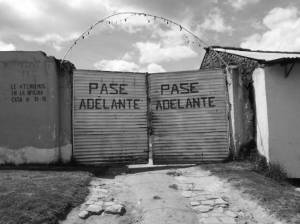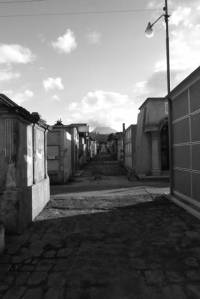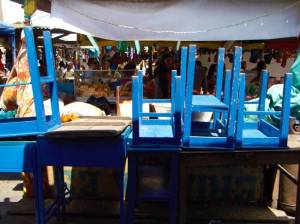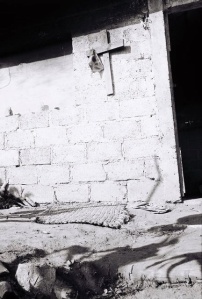“Entre Les Murs” in New York City
October 31, 2009
En route to visit the lovely and amazing AJ in Paris, I made two delightful discoveries. First, the Air France beverage service includes free Chardonnay. Second, in-flight programming offers passengers a choice between 16 movies, some still in theaters. One of them was Entre les Murs, or The Class, which won the Palme d’Or at Cannes a couple of years back.
Well done, Air France. Well done, Cannes. The Class is perhaps the most intelligent commentary on public education in the United States that I have seen, heard or read with my feet firmly planted on the ground, let alone when 30,000 feet above the Atlantic Ocean. Yes, The Class is set in the 20th arrondissement, not in Bed-Stuy or the Bronx. But this unassuming little film forcefully illustrates many of the challenges that emerge in the classroom, and exposes the clichés that characterize our public conversation about education reform.
I want you to move The Class to the top of your Netflix queue immediately, so I’m not going to pick apart all the intricacies of its plot, nor do I want to spoil the heartbreaking ending. Instead, I’m going to tell you a little bit about the central conflict of the film: the struggle between François, a literature teacher in a rough-and-tumble middle school, and Souleyman, his Malian student.
François is initially presented as a committed, compassionate teacher. We watch him engaging his class in a discussion of identity based on their reading of The Diary of Anne Frank, patiently explaining the definitions of unknown words, and responding to their subtle gestures of defiance with humor and wit. In turn, Souleymane seems to fit the stereotype of the angry, young Black man. Although the two clash early in the film, the conflict seems to be resolved when François recognizes that Souleymane refuses to complete homework assignments or participate in class discussions for one simple reason: he cannot read and write. When Souleymane submits a set of grainy but artful photos in place of an assigned autobiographical essay, François celebrates his talent, carefully pinning the images on the classroom walls. In these scenes, François’ class is the kind of vibrant, inclusive space that all teachers aspire to create.
But François’ fall from grace is swift. At a staff meaning to evaluate student progress, he tells the other teachers that Souleymane is incapable of progressing further. Two student representatives are present, and when they repeat François’ comment in class he lashes out, calling them “skanks” (an accusation with loaded racial undertones.) Souleymane defends them angrily and storms out of the class, accidentally hitting another student in the face with his book bag. The injury is grounds for expulsion, and François must decide whether to pursue disciplinary action. He knows that his comments provoked the incident, and that Souleymane’s father may send him back to Mali if he is expelled. But François is persuaded that the student’s defiance should not go unpunished. At the disciplinary hearing, François remains a voting member of the staff committee and Souleymane must translate the proceedings for his mother. When the committee delivers its verdict, it is Souleymane who tells her that he has been expelled.
The Class powerfully illustrates a central challenge within the classroom: how do you balance a legitimate interest in ensuring student safety, providing the structure kids need in order to learn, with the temptation of arbitrarily asserting your authority as a teacher or administrator? François is not the kind of abusive, failed teacher TFA recruiters point to as “the problem” with American education. He was a good teacher having a very bad day, but his emotional reaction to his students still had tragic consequences. Nor is Souleymane unredeemable. His anger is not arbitrary, and his defiance is largely defensive. If François had accepted the blame for the incident, he would have been forced to cede some of his authority within the classroom, but he might also have been able to find constructive ways to address Souleymane’s sense of frustration and isolation.
Souleymane’s story is not pure fiction. The Class can be read not only as a parable of the power-dynamics of the classroom, but also as a demonstration of the unexpected consequences of “zero tolerance” discipline policies. Although these policies originated as a response to the perception of rising school violence in the 1990s, they do little to address the underlying reasons why students act out in class, break school rules, or –in the most extreme cases- engage in violent activity. In New York City, “zero tolerance” philosophy drives Bloomberg’s “impact school” initiative. In January 2004, the mayor’s office announced changes in the district discipline codes and school security systems. Suspensions were mandated for a new range of violations, and increased numbers of NYPD officers were placed in facilities deemed insecure. (The NYPD replaced school security officers during the Giuliani administration.) It goes without saying that these “insecure facilities” are the under-resourced schools in low-income neighborhoods in the outer boroughs.
The impact school initiative has had dramatic results. During the 2004-2005 school year, superintendent’s suspensions increased by 33% (from approximately 11,000 to approximately 15,000. Stats from NYCLU) In theory, students who are expelled or suspended are sent to alternative “opportunity schools.” In reality, these students are more likely to stay on the streets than return to school. Police officers are also empowered to arrest students for in-school incidents, which means youth who previously might have spent time in the principal’s office are now sent to family court and, sometimes, detention. These policies contribute to the disgraceful racial disparities in the Juvenile Justice system: in New York City, between 95 and 98% of youth in detention are youth of color, despite the fact that they comprise less than two-thirds of all youth (NY Department of Juvenile Justice.)
(New Yorkers, when you go to the polls on Tuesday, please consider the fact that the Bloomberg administration has made no effort to address these disparities. Yes, “commuter taxes” and trees are nice and all, but they don’t make Bloomberg a progressive, and I for one don’t like the fact that the greatest of American cities has resurrected Jim Crow.)
To top it all off, the impact schools initiative hasn’t made schools any safer. While the Department of Education insists that their policies have reduced crime, the number of actual violent incidents in most schools has only decreased slightly. Moreover, the decrease in crime at impact schools is not statistically significant when compared with the simultaneous decline at other high schools (NYCLU: Criminalizing the Classroom.)
The outcomes of the impact schools initiative, then, are these: more kids pushed out of school and into the maze of the justice system.
Take my former student L. L is originally from New Orleans, and he and his mother and brother took refuge in the Superdome during Katrina. His grandmother died in the flooding. After the storm was over, L moved in with his mother’s family in New York. Understandably, he has serious issues with anger management. L was enrolled in Kindergarten during my first year, when I taught in the classroom next door. I knew him by his screaming. Administrators regularly dragged him out of the class when his behavior was unmanageable.
But the next year, things were different. My teacher had a reputation of knowing how to handle the “bad boys,” and L was assigned to her class. Mrs. S set clear boundaries, working with L’s mother to develop a behavior monitoring system that traced his progress. Initially, it was a struggle, but L came to respect Mrs. S and to take interest in her classroom. By Christmas, he was a different kid: hardworking, helpful, engaged. When praised, his whole face crinkled into a smile. He stayed in our classroom for 2nd grade, and he remained one of my very favorite students.
When L moved up to 3rd grade, he began to act out again. By the end of the year he had been suspended for hitting his teacher. Elementary students who are suspended are sent to other schools for the duration of their suspension, where they are placed in classrooms in which they receive no instruction or attention. I can only imagine that L spent the last two weeks of 3rd grade in a strange place, bored and making trouble.
Students like L and Souleymane are not a lost cause. They can be taught, and they can contribute to the classroom. Are they easy to teach? No, not at all. But they are worth all the trouble in the world.
This is It (Really)
October 29, 2009
 When I told my father that I was planning an ambitious post for today, he offered some wise advice: “Short and pithy is good too.” Fathers are smart. I’m having trouble getting this one quite right, and it’s about an issue that is especially dear to my heart, so I’m going to sleep on it and try again later……
When I told my father that I was planning an ambitious post for today, he offered some wise advice: “Short and pithy is good too.” Fathers are smart. I’m having trouble getting this one quite right, and it’s about an issue that is especially dear to my heart, so I’m going to sleep on it and try again later……
However, to thank you for checking in, and to mark the media hysteria surrounding the release of a certain almost-concert-film, I am proud to showcase D, the son of my Spanish teacher. You probably can’t tell, but in this photo he’s doing a darn-good job of dancing to “Billie Jean.” His little sisters and my Quiche teacher are the back-up singers.
Pop music has no borders.
Board Books and Photo Posts
October 26, 2009



 Once upon a time, I had the best summer job ever: I was paid to read picture books at the best children’s bookstore in the world. I did a respectable job of selling them too, but sadly too-few customers appreciated the genius of Mo Willem’s pigeon books. When I couldn’t sell the books I loved, I made use of my discount to buy them for other people. And so began my unfortunate habit of spending more money than I really ought on children’s books. (It’s an occupational hazard, I suppose.)
Once upon a time, I had the best summer job ever: I was paid to read picture books at the best children’s bookstore in the world. I did a respectable job of selling them too, but sadly too-few customers appreciated the genius of Mo Willem’s pigeon books. When I couldn’t sell the books I loved, I made use of my discount to buy them for other people. And so began my unfortunate habit of spending more money than I really ought on children’s books. (It’s an occupational hazard, I suppose.)
Now that I no longer have a class full of 8-year-olds to use as my excuse, my favorite picture-book-gift-recipient is CL, the Guatemalan daughter of my friend CE. I think CL’s favorite so far has been the classic “The Little Mouse, the Red Ripe Strawberry, and the Big Hungry Bear,” and her parents loved “Planting a Rainbow.” But I was particularly proud to present her with Jill Hartley’s bilingual board book series, which features beautiful pictures of patterns and colors in Latin America (see above.) I doubt most children will be clamouring to read these night after night as there isn’t any text, but if I were one-and-a-half I would totally want to chew on them, and chewing on books is an important, underappreciated stage in the development of literacy skills.
So, in honor of these beautiful books, here are the best of the patterns and colors I’ve come across here in the last few weeks. Check back Wednesday for a post on play!

A tomb in Xela's cemetery

The Church in Zunil

Dying thread in the weaving town of Salcaja

The Market in Xela

A thread store in Salcaja

A painted sign in Xela

Metal pots at the market in Momostenango

The Church at Salcaja: Purported to be the oldest in Guatemala. There are pineapples on the facade. No joke.

Paches (chile-flavored potato tamales), fresh tortillas, and herb tea in honor of the birthday of MS. Heaven on Saturday morning.
Language Lessons
October 21, 2009
 The last two posts might have left the impression that I stepped off the airplane in Guatemala City and began leading focus groups in customs. This is not true. Because, of course, researching bilingual education requires language skills. My Spanish is solid, reliable, but I wouldn’t take it home to meet the parents. It goes without saying that with the exception of three Nahuatl words I learned in Mexico (tashkal- tortilla, tasokamatik- thanks, semi’huilik- the tortillas are delicious), I do not speak any indigenous languages.
The last two posts might have left the impression that I stepped off the airplane in Guatemala City and began leading focus groups in customs. This is not true. Because, of course, researching bilingual education requires language skills. My Spanish is solid, reliable, but I wouldn’t take it home to meet the parents. It goes without saying that with the exception of three Nahuatl words I learned in Mexico (tashkal- tortilla, tasokamatik- thanks, semi’huilik- the tortillas are delicious), I do not speak any indigenous languages.
I am sure some of you are like my lovely former roommate R, who speaks five languages fluently and managed to attend Latin American Student Organization meetings without anyone suspecting that she is not, in fact, Argentinean. Props. Unfortunately, I am not so talented, and I grew up in Indiana. In my home state, we speak one and a half languages, American and a dialect known as Hoosier, and our school boards do not believe that foreign language instruction should begin before the age of 12. Consequently, during my prime language-learning years I attended a few after school French classes, where I learned to count to ten and ate a lot of éclairs.
Not content to accept my fate, I have spent half my life struggling to speak Spanish with fluency. I will spare you the story of how my initial enthusiasm drifted in the doldrums of high school, was revived by Gael Garcia Bernal’s turn as Che in The Motorcycle Diaries, and tested in college literature classes for which I was highly unqualified. Instead, I will open in the summer of 2007, when I set off on the Great Leftist Adventure known as Mexico.
I had spent ten days in Spain the month before, where several waiters, store keepers, and a few fellow train passengers told me that I spoke Spanish well. Naively, I assumed that once I arrived in Mexico, hitherto unseen Spanish knowledge acquired through years of AP test prep would somehow spring from my mouth.
Language Learning Lesson Number One: When you are a woman traveling alone and male waiters tell you that you speak a language well, you should not be fooled into believing that this is, in fact, true.
Suffice it to say that my tongue did not prove to be fertile ground for the Spanish language. I realized that I was in for the long haul when, on my first morning, I tried to share my thoughts about the British school system at the breakfast table. After I finished, everyone smiled vaguely and looked down at their cereal bowls. They hadn’t understood anything that I had said.
Language Learning Lesson Number Two: Learning to speak a foreign language is a profoundly humbling experience, and it requires total fearlessness and complete determination. Not to mention a good sense of humor.
The realization that I had overestimated my Spanish skills was a huge shock, and it made my first days in Mexico much more difficult than I had anticipated. In part, this realization was a necessary corrective to my arrogance. Early childhood educators spend years developing literacy skills: why did I assume I could make eight years of progress in seven weeks? This assumption is clearly rooted in the culture of elite American universities, where students are afraid to embarrass themselves in the classroom and attempt to create the illusion of effortless brilliance. Initially, I was terrified of making public mistakes, but eventually I realized that they were both inevitable and educational. Speaking Spanish day in, day out (with the exception of midnight tooth-brushing sessions with my dear friend L) continued to be terribly difficult. But over the course of the summer I finally acquired what I had lacked: an intuitive understanding of the structure and rhythm of Spanish. I spent the last few days alone in Mexico City, and on my final morning a family stopped me to ask for directions. I knew where they wanted to go, and I answered in perfect, fluent Spanish. To this day, it remains the crowning moment of my Spanish-speaking career.
Language Learning Lesson Number Three: Celebrate small victories.
After I graduated in May and started to process the fact that I was about to be paid to move to Central America, I realized that I was most alarmed by the prospect of trying to navigate the Global South without being fluent. I knew that I was about to step out of my comfort zone in a big way, and so I made a very good decision: I decided to spend my first four weeks in language school. After all, school is the place where I feel most at home.
Two weeks in, I’m very, very glad I decided not to start conducting focus groups in customs. Instead, I’m in Quetzaltenango (Xela), the second largest city and a hub for language schools like mine – Centro Maya, http://www.centromayaxela.org/. There are dozens of language schools in Xela, but I picked Centro Maya because it funds a scholarship program for indigenous women, offers indigenous language courses, and promises to pay its teachers a living wage. (Mexico cured me of Great Leftist Adventures, but I’m still a sucker for cooperatives.)

In Xela, I live with a host family: a grandmother, her daughter and her husband, and a beautiful one-year old girl. There’s also a Guatemalan university student who rents a room in the house, and this morning I woke up to the sound of him singing Spanish pop music in the shower.
Language Learning Lesson Number Four: Children and awkward boys help break the ice when adult language skills fail.
Living with a host family forces me to speak Spanish every day, and I’m learning a lot about how middle class Guatemalans live. (For example, did you know that 40 percent of Guatemalans are evangelical Christians? I didn’t until I moved in last Sunday, just after my family had returned from church.) They also feed me tasty tamales (see picture below in “Under the Ten.”)
Between 8 AM and 1 PM, I’m at school. I study Quiche – the local indigenous language- once a week, but Spanish keeps me plenty busy. I’m the only student, so my teacher, Pedro, and I start every day by talking in Spanish for an hour or two. After a mid-morning walk to the bakery for bread, we launch into hardcore grammar drills. It’s like high school Spanish, except this time I actually remember what I’m learning. Most importantly, every day I feel a little more confident and prepared to start work on my project in November.
To my complete surprise, I’m enjoying myself.
This is not to say that speaking Spanish is easy. But this time around I recognize why it’s really hard, and it’s not because speaking a foreign language requires regular public humiliation. I have a theory that gifted language learners are capable of totally reinventing themselves when necessary: learning a language is like acting a part in a play. But my sense of subject-hood is largely derived from 19th century British novels, which means I experience the loss of English as a loss of self. I don’t know how to make small talk, to explain my politics, or to talk about how and why we feel the way we do. For me, Spanish is difficult because speaking it requires that I rethink the way my sentences are structured, reconsider the images I employ, and learn to listen to new rhythms. It requires, on some level, that I re-imagine myself. I love the elegance of Spanish, and I love the messy beauty of Latin America, and I want to belong here in some small way. But there are days when I feel like a Jane Austen heroine who somehow got lost on the way to Bath.
Language Learning Lesson Number Five: Learning a language is painful, hilarious, and joyful all at once.
It is painful because it makes even the smallest interactions- talking to a taxi driver, making a telephone call- difficult. It is hilarious because it allows you to re-experience being five, when you shared very short sentences very enthusiastically, with much waving of your arms and self-deprecating laughter. It is joyful because there are magical moments of recognition when a passage in novel suddenly acquires meaning, when the first word that comes to mind is not English, or when you give good directions.
* Eventually I plan to post twice a week, but until things get going in November I’m going to do one photo post and one essay post a week. So check back next Monday for more!
.
Under the Ten
October 19, 2009
I’m in Quetzaltenango, or Xela (pronounced Shay-la, meaning “under the ten hills”) for the month. Check back tomorrow evening for a “real” post!



Santa Maria, the local volcano, hidden by clouds





“There is no one to teach us”
October 13, 2009

My "abuela" in Mexico, and the one room house in which she lives

In the summer of 2007, I participated in a seven week Quaker-funded, leftist-run work camp designed to support the indigenous women’s organization in the Nahuatl community of Z, located in Puebla, Mexico. Our task was to build water tanks and ecological stoves for women and their families. The ecological stoves burn significantly less firewood than open fires and pipe the smoke outside of the house, protecting the health of the women who cook over them. They’re easy to construct- sculpted out of concrete, sand, earth and lime mixed by hand.
Unfortunately, most families wanted water tanks, to collect rainwater for bathing and cleansing. I thought these tanks were fairly useless because the water still wasn’t potable, but we Americans spent a lot of time processing our imperialist tendencies, so I didn’t share my opinion. I was also biased, because I was absolutely no help when it came to actually building them. The organization hired an albañil, or bricklayer, to oversee construction. Maybe he was a little bit machista, maybe he recognized that underneath my spanking-new overalls and work gloves I was absolutely devoid of spade-wielding talent. W hatever the case, the bricklayer wouldn’t let us help. Consequently, I spent a lot of time feeling completely useless.
Now, dear reader, I can deal with my fair share of unfortunate experiences, but feeling like a waste of space and tortilla is not one of them.
As a result, I felt lost and alienated during my time in Mexico. But I remember one woman’s words as a brief moment of insight into the role I could play in confronting the challenges that the community faced. One of the houses where we “worked” was built high on a mountain overlooking a valley. The view was spectacular, and the stone home looked as if it had grown out of the cornfields. To pass the time, one of the women gave us a tour. In one bedroom, a chart was tacked onto the whitewashed walls. With its neat squares and colored letters, it seemed better suited to a high school chemistry lab than a simple bedroom in an isolated Mexican village. “Qué es ésto?” we asked the women. “The Nahuatl alphabet,” answered Doña E in her soft, slow Spanish. “Can you read it?” we responded. “No.” “Would you like to learn?” “Yes, but there is no one to teach us.”
What if Doña E and other women had a teacher, and what if they learned to read? These women are tough: their quiet strength holds the community together in the face of poverty and migration. Many have watched their children leave the town to work in the capital, the northern farms, or the United States. They remain behind, raising their grand children or great grandchildren. They tend the milpa and carry the firewood: they grind the corn and pat the masa into the perfect rounds that are eaten at every meal. Although worn by work, these women welcomed us and cared for us, teaching me the true meaning of hospitality.

But indigenous women lack power. Men dominate community organizations: at meetings for the women’s group, only the male coordinator spoke. The blouses they embroider are sold to tourists. The women are paid only $2 for 10 days of labor. Moreover, some women are powerless in their own homes. The husband of my “abuela” had deserted the family many years before, and even the wife of the male head of the women’s organization complained of emotional and occasional physical abuse.
In Guatemala, these common problems are compounded by the violent legacy of a thirty-year civil war. Close to three hundred thousand Guatemalans were killed or disappeared by the police and the military, culminating in the massacre of entire Mayan communities in the early 1980s. Sexual violence against indigenous women was common. The United States is complicit in this violence. Not only did the CIA support the 1954 coup that ousted the moderate socialist Jacobo Arbenz, but it also provided training in counter-insurgency “techniques” just prior to the first reported disappearances in 1966. Activists like Rigoberta Menchú have been successful in raising international interest in the plight of indigenous communities, but the memory of the conflict remains a point of violent contention in Guatemala.
I am not foolish enough to believe that simply teaching women basic literacy skills is enough to end centuries of violent exploitation or overturn a global economic system rooted in inequality. But when Doña Elena answered our questions about the Nahuatl alphabet, I realized that as long as they are unable to read and write (and to acknowledge trauma and fear) women like those I met in Mexico will remain dependent, unable to give voice to their collective challenges and shared dreams. At the very least, the classroom can be a space where these issues can be addressed openly, without shame. Obviously, I’m not the first person to connect a lack of education with oppression, which is why I’ve come here to Guatemala, to learn from leftists and indigenous rights activists who have been doing this work for years.
On a more personal level, I owe a debt to the women of Z. As I worked through my frustration with my experience in Mexico, I realized how much they had taught me about power and politics during my time in Puebla. I also recognized that I am not totally useless. I have no skill with a spade, but language is something akin to a trade. Here in Guatemala, I’ll try to put it to good use.

For four years, I attended college, but I also went to school. Two (sometimes three) days a week, I woke up at eight, trooped to the Avery Café for eggs-and-cheddar on a bagel, and carried my coffee through Morningside Park to my job as an assistant teacher at PS X. For four years, I played with letter-sound puzzles and addition card games, listened as my students struggled to sound out words and add dialogue to their stories. I corrected homework and filed endless (usually useless, legally mandated) assessments. Faced with a weekly onslaught of childhood disease germs, my immune system became the stuff of legend. I was even, briefly, the math fairy (but that’s another story.)
At the end of each year, my students wrote me thank you notes. I would like to think that these cards were a spontaneous expression of gratitude for all those graded homework packets. But although my Irish ‘fro has never been so lovingly rendered in magic marker, I know that the notes were the product of a carefully orchestrated Teachable Moment. The class probably sat in a circle on the carpet as the (always fabulous) Mrs. S explained that Miss. Hulse had just graduated from college and was about to move away. Perhaps my students searched for Guatemala on the map, and then sounded it out, syllable by syllable. At the end of the lesson, Mrs. S wrote a model on the white board, which I imagine went something like this:
“Dear Miss. Hulse,
Thank you for reading and writing with me. Congratulations on graduating from college. Have fun in Guatemala!
Love, Second Grader”
M used the new vocabulary words written on the board, but he didn’t use them quite correctly. On the cover of his construction paper card, he wrote “Congratulations for reding with me.”
The teacher in me groaned, realizing that many rounds of “ea” word bingo had been played in vain. But I knew that, unwittingly, M had told the truth. Because I did more than file tests and wipe noses in my four years of teaching; I also served as a witness to those magical moments in which a child moves from sounding out words to seeing instantaneous meaning, from articulating vowel sounds to articulating identity and experience.
The students I loved the most were not necessarily the most fluent readers or expert writers. Instead, they shared a common ability to link the stories we read with the reality they lived. They included A, the child of African immigrants who confused “n” and “r” but spoke thoughtfully and seriously about the violent death of Martin Luther King. And J, a hold-over student raised by her grandmother and 21-year-old aunt who, after reading a series of books set in Harlem, observed how hard poor women must work to provide for their families. And finally, S, a girl with a sassy attitude and sly smile who explained why the heroine of Tar Beach dreams that she can claim buildings and bridges by flying over them. “In her imagination,” S said, “she is free.”
The world was theirs for the reading.
I don’t think I can take credit for these moments, but I do believe that teachers can help create the spaces where transformative learning happens. My questions, then, are these: What does it mean to teach for freedom? What might a practical pedagogy look like it, and how does policy support or inhibit learning? Finally, what might the classroom tell us about the politics that surround it?
I’ll be spending the next ten months in Guatemala, where I’ll reflect on these questions by researching bilingual literacy programs that serve indigenous women. I don’t expect to come up with definite answers, but I’ll be recording my experiences and observations all the same. I hope you’ll keep “reding” with me.
